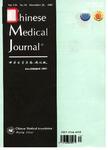The ectopic study of tissue-engineered bone with hBMP-4 gene modified bone marrow stromal cells in rabbits
The ectopic study of tissue-engineered bone with hBMP-4 gene modified bone marrow stromal cells in rabbits作者机构:ShanghaiKeyLabofStomatologyOralandMaxillofacialSurgeryDepartmentNinthPeople'sHospitalShanghaiSecondMedicalUniversityShanghai200011China LifeScienceCenterPekingUniversityBeijing100871China epartmentofBiomedicalEngineeringFacultyofMedicineUniversityofAlbertaCanada ShanghaiKeyLabofStomatologyOralandMaxillofacialSurgeryDepartmentNinthPeople'sHospitalShanghaiSecondMedicalUniversityShanghai200011China
出 版 物:《Chinese Medical Journal》 (中华医学杂志(英文版))
年 卷 期:2005年第118卷第4期
页 面:281-288页
核心收录:
学科分类:1002[医学-临床医学] 100210[医学-外科学(含:普外、骨外、泌尿外、胸心外、神外、整形、烧伤、野战外)] 10[医学]
基 金:ThisStudywassupportedpartiallybyTechnologyandDevelopmentProgramofChina( 863project No 2002AA205011 ) andNaturalScienceFoundationinShanghai(No 03ZR14080)
主 题:tissue engineering bone morphogenetic protein bone marrow stromal cells gene therapy
摘 要:Background Tissue-engineering techniques combined with gene therapy have beenrecently reported to improve osteogenesis. In this study, tissue-engineered bone constructed byhuman Bone Morphogenetic Protein 4 (hBMP-4) gene-modified bone marrow stromal cells (bMSCs) wasexplored in an ectopic bone formation model in rabbits. Methods A pEGFP-hBMP-4 mammalian plasmid (EGFP: Enhanced Green Fluorescent Protein) was constructed by subcloning techniques. bMSCs obtainedfrom rabbits were cultured and transfected with either pEGFP-hBMP-4, pEGFP or left uninfected invitro. Transfer efficiency was detected through the expression of EGFP. Transcription of the targetgene was detected by RT-PCR. Alkaline phosphatase (ALP) and Von Kossa tests were also conducted toexplore the phenotypes of osteoblasts. The autologous bMSCs of the 3 groups were then combined withNatural Non-organic Bone ( NNB) , a porous hydroxyapatite implant with a dimension of 6 mm x 6 mm x3 mm, at a concentration of 5 x 10~7 cells/ml. They were subsequently implanted into 6 rabbitssubcutaneously using NNB alone as a blank control (6 implants per group). Four weeks after surgery,the implants were evaluated with histological staining and computerized analysis of new boneformation. Results pEGFP-hBMP-4 expression plasmid was constructed. Under optimal conditions, genetransfer efficiency reached more than 30% , Target gene transfer could strengthen the transcriptionof BMP-4, and increase the expression of ALP as well as the number of calcium nodules. In theectopic animal model, NNB alone could not induce new bone formation. The new bone area formed in thebMSCs group was (17.2 ± 7.1)%, and pEGFP group was (14.7 ± 6.1) % , while pEGFP-hBMP-4 group was(29.5 ± 8.2) % , which was the highest among the groups (F = 7.295, P 0. 01). Conclusions Themammalian hBMP-4 expression plasmid was successfully constructed and a comparatively high transferefficiency was achieved. The gene transfer technique enhanced the expression of BM



